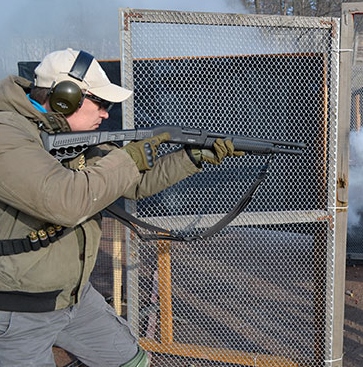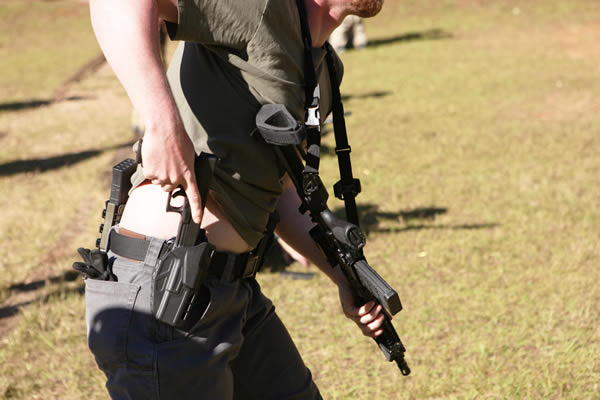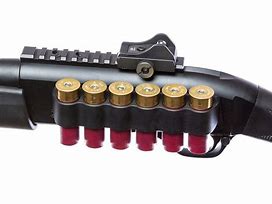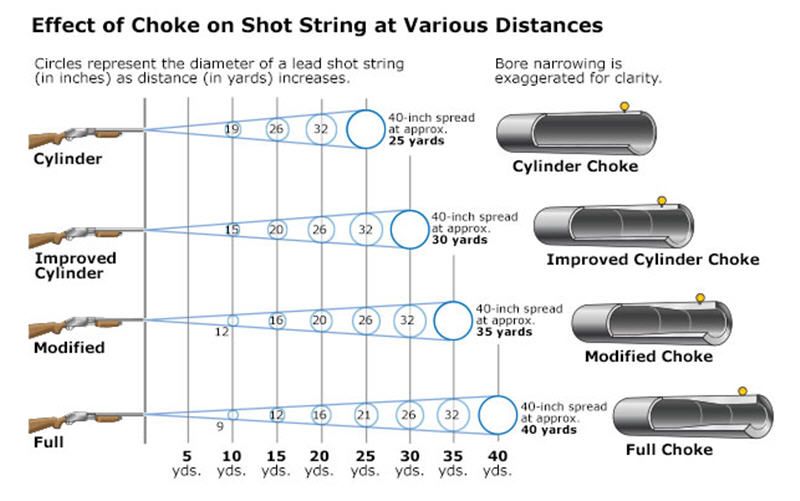About the Idaho Defensive Shotgun Class 101

Our Idaho Defensive Shotgun Class 101 focuses on utilizing a shotgun for self-defense. The training focuses on protecting your home or business during an invasion. This is the original Level 1 Firearms Defensive Shotgun Class.
Students need to know and demonstrate safe gun handling, familiarity, and efficiency when handling shotguns, fundamental marksmanship skills, and working from a holster. Our Idaho Beginner Shotgun Classes 101 and Idaho Defensive Pistol Classes 101 are prerequisites for this shotgun training event.
Students who will be introduced to safety requirements, or who cannot demonstrate the skills required for this class will be removed from training. Please read through the class description and fully understand our prerequisite training requirements before registering for this training event. We have included some examples of what is covered in this class.
Transitioning from Shotgun to Pistol

If your shotgun fails or runs out of ammunition, you’ll need to transition to your handgun. Time is critical now, and it’s working against you as you sling your shotgun to present your pistol. If the transition can be avoided, this is not the time advantage you want to provide to your attacker.
During this time, you’ll need a sling to maintain control of your shotgun. If you don’t have a sling, you must train to drop the shotgun as you transition to the pistol. As with any self-defense scenario, you never want to leave a firearm behind unless you have absolutely no other options available.
Loading and Unloading Techniques

If you’re going to use a shotgun for home or business defense, you have to be serious about having enough ammunition available during a fight.
While it’s nearly impossible to miss your aggressor within tight quarters, there’s always a chance they have found sufficient cover to protect themselves. This course covers the options available to reload and how to do it as quickly and efficiently as possible.
Understanding Shotgun Chokes

When using a shotgun as a home or business defense option, it becomes critical to study and understand how shotgun chokes can affect the spread of pellets when they leave your shotgun.
While shotgun chokes were introduced and discussed during the Idaho Beginner Shotgun Class, details about chokes were not covered in depth. During a defensive shotgun encounter, you must understand which choke works best for you and the intended use of the shotgun.
This Is A Two Day Class!
Why is this a 2-day class? Our Idaho Defensive Shotgun 101 Class is the best training you will receive in Idaho, there are no shortcuts in learning how to own and use a pistol properly.
We train using Modern Gun Training Techniques, ensuring you will know everything you need to know by the end of class. We want you to be taught entirely when handling a firearm.
Indoor ranges in Idaho do not accommodate outside instructors which makes no sense – we are literally bringing them, customers! We have chosen to utilize one of the several outdoor ranges in the Treasure Valley that like us bringing them, customers. Indoor ranges are loud, really loud. You cannot hear the instructor while training and are extremely restrictive with what we can teach.
Outdoor ranges provide freedom of teaching without the loud distraction you experience when training in an indoor range. We can take our time training – there’s no rush – you’re not paying a lot of money per hour, students can hear us, there are little to no distractions, and there’s no need to rush you through the skill-building portion of class. You learn in a safe, comfortable, and fairly quiet environment.
Outdoor ranges are extremely hot or cold in the late afternoons which distracts new students from concentrating. By shooting early the the following day, students are fresh and ready to train for their new shooting skills.
This Course is for Pump or Semi-Automatic Shotguns Only
Prerequisites:
- Idaho Shotgun Essentials 102 Course or Equivalent and
- Idaho Enhanced Concealed Carry Permit, or
- Idaho Standard Concealed Carry Permit, or
- Proof of Current Active Military, or
- Official Background Check provided by a state or federal agency within the past 90 days.
Adherence to the primary safety rules must always be followed.
- Keep the Firearm Pointed in a Safe Direction.
- Keep the Firearm Unloaded Until Ready to Use.
- Keep Your Finger Off The Trigger Until Ready to Shoot.
- Know Your Target and Beyond.
- No Drugs, Alcohol, nor Cannabis are Allowed At The Range.
Equipment:
Day 1: Classroom – Saturday
- Notepads, pens, paper.
- Any acceptable shotgun action.
- Shotguns must be reliable and mechanically sound.
- A shotgun that accepts a 2¾” shotgun shell or shorter (3″ and 3½” length shells are not allowed).
- The shotgun can be a .410 to a 12-Guage caliber.
- You prefer to bring the shotgun you intend to use for short-range shooting.
- If purchasing a new shotgun for this class, it is recommended to attend our Idaho Shotgun Essentials 101 to learn more about shotguns.
- A Semi-automatic pistol ranging from .9mm to .45 ACP
- 3-pistol magazines
- Belt mounted dominant side holster.
- Magazine Pouch capable of holding 2-spare magazines.
- Sturdy Gun Belt at least 1.5″ wide.
- Suitable Eye Protection. This can be wraparound eyewear, polycarbonate lenses, or non-shattering prescription glasses.
- Suitable Ear Protection. We recommend electronic noise-canceling earmuffs, but earplugs are acceptable.
- Knee and Elbow Pads – for range day and private shooting drills afterward.
- Ground Covering for Prone Shooting Positions
- Two-Point Shotgun Sling.
- Shotgun Case for transporting your rifle.
- Side Straddle Shot Shell Holder.
- Training Shot Shells (Dummy Rounds): At least 5 Training Shot Shells in the correct caliber are needed for this class.
- Don’t forget, if you have two different shotgun gauges, you will need two different-sized training shells.
- Can be found at local sporting goods stores or online. Purchase ahead of class so you have what you need – this is not a last-minute purchase item.
- Pistol Training Cartridges: At least 5 Training Cartridges in the correct caliber are needed for this class.
- Optional, not required, and unnecessary would be a mounted Shotgun Scope or Red-dot scope.
Estimated Length: 6 Hours
Day 2: Range Day – Sunday
- Pump-Action or Semi-automatic shotgun is reliable and mechanically sound.
- A shotgun that accepts a 2¾” shotgun shell or shorter (3″ and 3½” length shells are not allowed).
- The shotgun can be a .410 to a 12-Guage caliber.
- It is preferred you bring the shotgun you intend to use for short-range shooting.
- If purchasing a new shotgun for this class it is recommended to attend to learn more about shotguns.
- A Semi-automatic pistol ranging from .9mm to .45 ACP
- 3-pistol magazines.
- Belt mounted dominant side holster.
- Magazine Pouch capable of holding 2-spare magazines.
- Sturdy Gun Belt at least 1.5″ wide.
- Suitable Eye Protection. This can be wraparound eyewear, polycarbonate lenses, or non-shattering prescription glasses.
- Suitable Ear Protection. We recommend electronic noise-canceling earmuffs, but earplugs are acceptable.
- Knee and Elbow Pads – for range day and private shooting drills afterward.
- Ground Covering for Prone Shooting Positions
- Two-Point Shotgun Sling.
- Shotgun Case for transporting your rifle.
- Side Straddle Shot Shell Holder.
- Training Shot Shells (Dummy Rounds): At least 5 Training Shot Shells in the correct caliber are needed for this class.
- Don’t forget, if you have two different shotgun gauges, you will need two different-sized training shells.
- Can be found at local sporting goods stores or online. Purchase ahead of class, so you have what you need – this is not a last-minute purchase item.
- Pistol Training Cartridges: At least 5 Training Cartridges in the correct caliber are needed for this class.
- Check the weather report on the day of class and bring appropriate clothing.
- Sunscreen or jackets when needed.
- Beverages for Hydration.
- Wear appropriate clothing for the weather.
- Bug Spray for the critters.
- No V-neck or similar shirts.
- Suitable and Comfortable Footwear, no open-toed shoes are allowed.
- Bring snacks for breaks. Snacks – Are allowed at the range – snacks are not allowed on the firing line.
- Range Fees, if any, are the student’s responsibility and are not included with the course registration.
Ammunition
- 20 rounds of buckshot.
- 65 Rounds of rifled slugs.
- 290 rounds of #6-8 birdshot.
- 100 Rounds handun ammunition.
Additional Information
- Lead core ammunition is used on steel only.
- No green/brown tip or armor-piercing ammunition is allowed.
- Note: Use of reloaded or steel-core ammunition will cause immediate failure and expulsion from class.
Optional but highly recommended:
- Small Personal Canopy during the summer season when temperatures are expected to be high.
- Folding chair and a small folding table to create your own workstation (bench).
Estimated Length: 8 Hours
